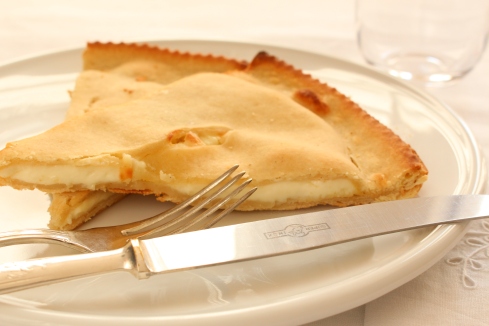Focaccia di Recco is a delicious snack that can be enjoyed any time during the day. When we think about focaccia, we usually think about bread dough with yeast; instead the peculiarity of the focaccia di Recco is the lack of yeast! For this reason it is also good for people who are intolerant to this ingredient.
It takes its name from the town of Recco in the Ligurian Riviera di Levante. The dough is very simple, made with flour, extra virgin olive oil, salt and water. The filling is stracchino or crescenza, a soft cow’s-milk cheese with a mild and delicate flavor. The name stracchino comes from the Italian word “stracca” meaning tired. This refers to the fact that the milk from the tired cows coming down in autumn from the alpine pastures, is richer in fat and it has a characteristic taste. The delicious combination of this dough and stracchino makes this preparation unique, a special treat for both adults and children. My kids love it for a quick lunch after school or for an afternoon snack. You can also serve it as a tasty appetizer with a glass of prosecco.
The history of focaccia di Recco is ancient and dates back to the third crusade. It was an affordable food when only simple ingredients were available. At the end of the 1800s it was added to the menu of the various local trattorie (rustic restaurant) as a special dish for the Day of the the Dead, celebrated on November 1st. Today it is enjoyed all year round and not just in Liguria!
FOCACCIA DI RECCO
Preparation time: 150 min . Cooking time : 10 min. Servings : 6 people
INGREDIENTS
320 g (2 cups) Mannitoba flour
200 ml (1 scarse cup) water, room temperature
8 g (1 heapping teaspoon) salt
45 ml (3 tablespoons) olive oil (Extra virgin)
500 g (19 oz) stracchino or crescenza cheese
DIRECTIONS
1. In a medium bowl combine water and oil, then dissolve salt
2. Place the flour in a large bowl, add the liquid. Start mixing with a fork incorporating the flour little by little, then mix with a wooden spoon until you obtain a smooth dough. Transfer to a floured work surface and knead (about 10 min.) with your hands until the mixture is uniform and elastic. Wrap in plastic paper and let it rest for about two hours at room temperature
3. Divide the dough into two equal parts and roll out with a rolling pin on a floured work surface trying to keep it as round as possible and pretty thin, about 1.5 cm. Now the hard part comes: you’ll have to pull the dough with your hands (floured) until it is almost transparent. It is important not to have holes in the dough, otherwise the cheese will come out when it bakes
4. Preheat oven to 230 °C (450 °F)
5. Grease a round baking pan (30 cm, 12 inch diameter) with olive oil and place a sheet of dough on it, cover with the cheese cut into pieces (not too small). Cover with the other sheet, sealing the edges well with your hands and pinching the surface 5 or 6 times. Brush the top with olive oil
6. Bake for 10-15 minutes until the surface is golden Serve hot. If there is any left which you can it heat it again in a hot oven for a few minutes. Paola
















